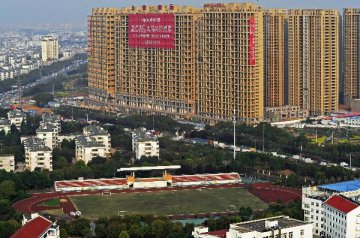
The National Bureau of Statistics (NBS) recently released data about investment in national real estate development and housing sales in 2016. In terms of floor area, property sales jumped by 22.5 percent to 1.573 billion square meters, while in terms of value, sales rose by 34.8 percent to 11.76 trillion yuan, both of which hit new high.
The statistics showed that investment in real estate development totaled 10,258.1 billion yuan in 2016, a nominal increase of 6.9 percent year on year (the real growth rate was 7.5 percent, after deducting price factors). Noticeably, nominal growth of investment in real estate development was only 1.0 percent in 2015, so it hiked significantly last year.
Meanwhile, typical indicators of real estate industry all picked up. In 2016, the floor space under construction by the real estate development enterprises accounted for 7,589.75 million square meters, up by 3.2 percent over 2015. The floor space started last year was 1,669.28 million square meters, up by 8.1 percent. The floor space of buildings completed stood at 1,061.28 million square meters, up by 6.1 percent. The land area purchased by the real estate development enterprises totaled 220.25 million square meters, a decrease of 3.4 percent over 2015. The total transaction of land reached 912.9 billion yuan, increasing by 19.8 percent.
Booming property sales was the major contributor to remarkable improvement in indicators. Based on the statistics, the floor space of commercial buildings sold exceeded 1 billion square meters in 2010 for the first time but declined in 2014 and 2015 after hitting a new high of 1.3 billion square meters in 2013. It surged to 1.573 billion square meters in 2016. Sales value followed the same trend as floor space. It recorded 5.27 trillion yuan in 2010, jumped to over 8 trillion yuan in 2013 and then soared to 11.76 trillion yuan last year.
Experts viewed that with change in population demand and structure, 2016 may be a year when the real estate industry saw a peak. Influenced by regulation and demand, real estate industry was under great pressure in 2017.
In 2016, the sources of funds for real estate development enterprises reached 14.42 trillion yuan, up by 15.2 percent when compared with that in 2015. Specifically, the domestic loans stood at 2.15 trillion yuan, rising by 6.4 percent; foreign investment fell by 52.6 percent to 14 billion yuan; personal mortgage loans totaled 2,440.3 billion yuan, up by 46.5 percent.
Housing inventories recovered again after diving for 9 consecutive months. At the end of 2016, the floor space of commercial housing for sale reached 695.39 million square meters, representing an increase of 44.4 million square meters compared with that at the end of November.
Jiang Chao, chief economist from Haitong Securities Co., Ltd., indicated that tier-1 cities attract more funds. But in terms of deposit data, growth rate of deposits in tier-1 cities has declined drastically and is far lower than growth in loans. It means that banks’ lending ability is weakening and also indicates that risk that housing price will be adjusted becomes bigger.
Jiang said that historically, housing price will never rise without any decline and prosperity in real estate industry created by residents increasing leverage rapidly in a short term covers irrational factors, which is difficult to sustain. So this makes current currency flow structure and flow direction difficult to sustain for a long term.
Zhang Dawei, chief analyst from Centaline Property, believed that in 2017, transaction volume in tier-1 and tier-2 cities will shrink greatly year on year due to restriction in policy, and sales in tier-3 and tier-4 cities will also decrease as it is hard for market fundamentals to back up high growth although these cities will continue to enjoy favorable policies of reducing housing inventories. On the whole, transaction volume of housing across the country will return to the level in 2015. At the same time, the floor space newly started is predicted to experience negative growth owing to higher inventories. The real estate market will say goodbye to rapid growth and get back to stable level.
Translated by Vanessa




















Latest comments